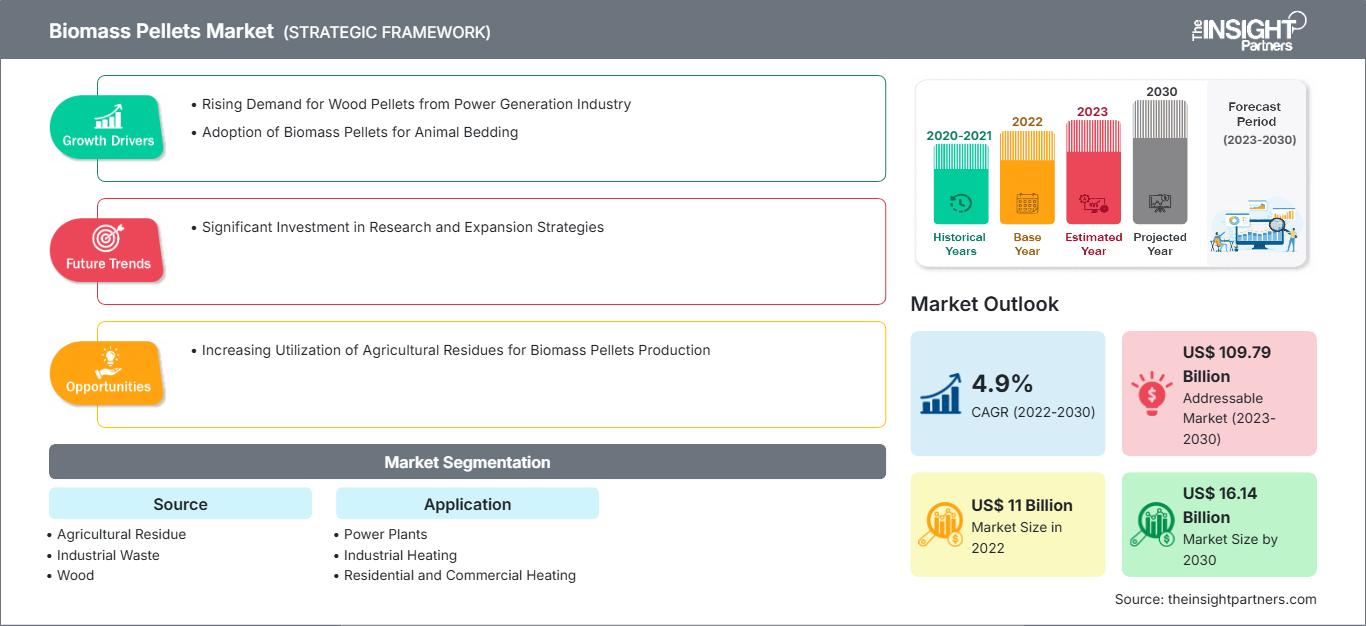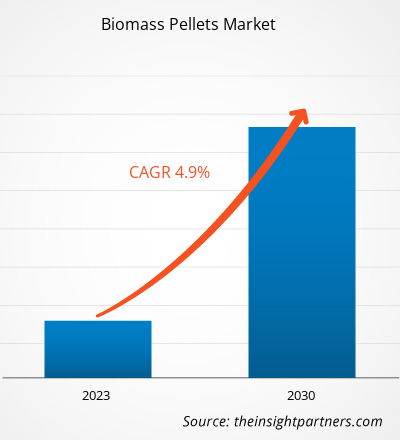[Forschungsbericht] Der Markt für Biomassepellets wurde im Jahr 2022 auf 11.001,59 Millionen US-Dollar geschätzt und soll bis 2030 16.137,89 Millionen US-Dollar erreichen; von 2022 bis 2030 wird eine durchschnittliche jährliche Wachstumsrate (CAGR) von 4,9 % erwartet.
Markteinblicke und Analystenmeinung:
Biomassepellets sind hochverdichtete, verarbeitete Biomasse, die in kleine zylindrische Formen gepresst wird. Sie werden aus organischen Materialien wie landwirtschaftlichen Rückständen, Holzabfällen, Holzspänen, Sägemehl und Waldresten gewonnen. Biomassepellets werden zur Stromerzeugung sowie in Heizanwendungen im privaten, gewerblichen und industriellen Bereich eingesetzt. Sie bieten gegenüber unverarbeiteter Biomasse viele Vorteile, wie standardisierte Eigenschaften, einen hohen Energiegehalt, gute Lagerfähigkeit und einfachen Transport. Biomassepellets, insbesondere Holzpellets, werden häufig in Pelletöfen und -kesseln für Privathaushalte verwendet. Die Bemühungen der Regierung, Treibhausgasemissionen zu reduzieren und die Nutzung von Biomassepellets zu fördern, treiben das Wachstum des Biomassepelletsmarktes voran.
Wachstumstreiber und Herausforderungen:
Mit dem zunehmenden Fokus auf Nachhaltigkeit ist die Nachfrage nach Biomassepellets wie Holzpellets deutlich gestiegen. Holzpellets können als Alternative zu Kohle zur Stromerzeugung eingesetzt werden. Darüber hinaus sind Biomassepellets gleichmäßig geformt, haben eine hohe Dichte und sind gut transportierbar und lagerfähig. Die Nachfrage nach Holzpellets für Stromerzeugungsanwendungen ist stark gestiegen. In Europa und Nordamerika sowie in asiatischen Ländern wie China, Japan und Südkorea werden Holzpellets hauptsächlich zur Mitverbrennung in Kohlekraftwerken eingesetzt. Weltweit nimmt die Verwendung alternativer Materialien zu Kohle in Großkraftwerken zu. Im Jahr 2021 ordnete das indische Energieministerium die Verwendung von Biomassepellets im Brennstoffmix mit Kohle in allen Kohlekraftwerken zu mindestens 5 % an. Solche Vorgaben treiben das Wachstum des Biomassepelletsmarktes in Indien voran. Darüber hinaus bezogen die großen Energieversorger in mehreren europäischen Ländern wie den Niederlanden und Belgien laut dem US-Landwirtschaftsministerium Biomassepellets aus den USA, Russland und Kanada. Somit treibt die steigende Nachfrage der Energieindustrie nach Holzpellets den Markt für Biomassepellets an. Biomassepellets werden aus organischen Materialien wie Holz, landwirtschaftlichen Rückständen und Industrieabfällen gewonnen. Viele Länder betrachten Biomassepellets als nachhaltige Brennstoffquelle; es gibt jedoch einige Umweltbedenken im Zusammenhang mit Biomassepellets. Bei der Verbrennung von Biomassepellets werden Schadstoffe wie Feinstaub, Stickoxide und flüchtige organische Verbindungen in die Luft freigesetzt. Zudem ist die Produktion von Biomasse mit einem erheblichen Wasserverbrauch für die Verarbeitung verbunden. Daher behindern die Umweltbedenken im Zusammenhang mit Biomassepellets das Wachstum des Marktes für Biomassepellets.
Passen Sie diesen Bericht Ihren Anforderungen an
Sie erhalten kostenlos Anpassungen an jedem Bericht, einschließlich Teilen dieses Berichts oder einer Analyse auf Länderebene, eines Excel-Datenpakets sowie tolle Angebote und Rabatte für Start-ups und Universitäten.
Markt für Biomassepellets: Strategische Einblicke

- Holen Sie sich die wichtigsten Markttrends aus diesem Bericht.Dieses KOSTENLOSE Beispiel umfasst Datenanalysen, die von Markttrends bis hin zu Schätzungen und Prognosen reichen.
Sie erhalten kostenlos Anpassungen an jedem Bericht, einschließlich Teilen dieses Berichts oder einer Analyse auf Länderebene, eines Excel-Datenpakets sowie tolle Angebote und Rabatte für Start-ups und Universitäten.
Markt für Biomassepellets: Strategische Einblicke

- Holen Sie sich die wichtigsten Markttrends aus diesem Bericht.Dieses KOSTENLOSE Beispiel umfasst Datenanalysen, die von Markttrends bis hin zu Schätzungen und Prognosen reichen.
Berichtssegmentierung und -umfang:
Der globale Markt für Biomassepellets ist nach Quelle, Anwendung und Geografie segmentiert. Basierend auf der Quelle ist der Markt für Biomassepellets in landwirtschaftliche Rückstände, Industrieabfälle, Holz und Sonstiges segmentiert. Basierend auf der Anwendung ist der Markt für Biomassepellets in Kraftwerke, Industrieheizungen, Heizungen für Wohn- und Gewerbegebäude und Sonstiges segmentiert. Nach der Geografie ist der Markt für Biomassepellets in Nordamerika (USA, Kanada und Mexiko), Europa (Deutschland, Frankreich, Italien, Großbritannien, Russland und übriges Europa), Asien-Pazifik (Australien, China, Japan, Indien, Südkorea und übriger Asien-Pazifik-Raum), Naher Osten und Afrika (Südafrika, Saudi-Arabien, Vereinigte Arabische Emirate und übriger Naher Osten und Afrika) und Süd- und Südamerika unterteilt. Mittelamerika (Brasilien, Argentinien und übriges Süd- und Mittelamerika)
Segmentanalyse:
Der Markt für Biomassepellets ist nach Herkunft in landwirtschaftliche Rückstände, Industrieabfälle, Holz und Sonstiges unterteilt. Das Holzsegment hält den größten Anteil am Markt für Biomassepellets und dürfte im Prognosezeitraum deutlich wachsen. Biomassepellets werden aus Holzabfällen wie Sägemehl, Holzschnitzeln, Hobelspänen, Rinde und anderen Reststoffen aus der Holzbearbeitung, aus Sägewerken und der Holzverarbeitung hergestellt. Die Holzabfälle werden gesammelt, verarbeitet, getrocknet und pelletiert. Holzbiomassepellets werden häufig in Heizungsanlagen für Wohngebäude, Industrieöfen und Kraftwerken eingesetzt.
Regionale Analyse:
Geografisch ist der Markt für Biomassepellets in fünf Schlüsselregionen unterteilt: Nordamerika, Europa, Asien-Pazifik, Süd- und Mittelamerika sowie Naher Osten und Afrika. Der globale Markt für Biomassepellets wurde von Europa dominiert, auf das im Jahr 2022 rund 6.478 Millionen US-Dollar entfielen. Der zweitgrößte Beitragszahler ist der asiatisch-pazifische Raum, der im selben Jahr mehr als 30 % des globalen Marktanteils für Biomassepellets ausmachte. Nordamerika wird im Prognosezeitraum voraussichtlich eine durchschnittliche jährliche Wachstumsrate von über 4,5 % verzeichnen. In Nordamerika wird der Markt für Biomassepellets maßgeblich von der regionalen Kostenwettbewerbsfähigkeit von Biomassepellets im Vergleich zu Heizöl und Propan angetrieben. Die Produktion von Holzpellets in Nordamerika hat in den letzten Jahren aufgrund der steigenden Nachfrage aus Überseemärkten an Fahrt gewonnen. Nach Angaben des US-Landwirtschaftsministeriums beliefern die USA und Kanada Kraftwerke in den Niederlanden und Belgien mit Holzpellets. Der Anstieg der Inlandsnachfrage nach Biomassepellets in der Region hat die Hersteller dazu veranlasst, ihre Produktionskapazitäten zu erweitern. Im Jahr 2023 investierte Grand River Pellets (Kanada) 30 Millionen US-Dollar, um die Produktionskapazität für Biomassepellets von 140.000 auf 220.000 Tonnen pro Jahr zu erweitern. All diese Faktoren treiben das Wachstum des Biomassepellets-Marktes in Nordamerika voran.
Branchenentwicklungen und zukünftige Chancen:
Nachfolgend sind verschiedene Initiativen der wichtigsten Akteure auf dem Biomassepellets-Markt aufgeführt:
- Im September 2022 eröffnete Enviva Inc. seine neu errichtete Anlage zur Herstellung von Holzpellets in George County, Mississippi (USA). Das Werk nahm Anfang 2022 den Produktionsbetrieb auf und erreicht eine zulässige jährliche Produktionskapazität von 750.000 Tonnen pro Jahr (MTPY).
- Im April 2022 eröffnete Drax Group PLC eine neue Pelletanlage in Demopolis im US-Bundesstaat Alabama. Die Anlage produziert jährlich nachhaltige Biomassepellets aus Sägewerksrückständen wie Sägemehl, Hackschnitzeln und Hobelspänen.
- Im Dezember 2020 brachte Pure Biofuel Ltd. ENPOWER-Holzpellets auf den Markt. ENPOWER-Holzpellets-Säcke entsprechen den A1-Qualitätsstandards, die vom UK Pellet Council und dem Europarat festgelegt wurden. Dieses Produkt ist in 10-kg- oder 15-kg-Paketen erhältlich.
- Im April 2021 übernahm die Drax Group PLC die Pinnacle Renewable Energy Inc. Mit der Übernahme lieferte die Drax Group PLC Bioenergie mit CO2-Abscheidung und -Speicherung (BECCS) und entfernt so jährlich dauerhaft Kohlendioxid aus der Atmosphäre.
- Im Mai 2023 erwarb die LEAG Group die Wismar Pellets GmbH von Metropolitan Equity Partners, einem Private-Equity-Investor, in einem Bieterverfahren, um das Produktions- und Lieferportfolio ihrer Raffineriebetriebe zu erweitern. Diese Übernahme wird der LEAG Group helfen, eine größere Anzahl von Kunden zu bedienen.
Markt für Biomassepellets
Die Analysten von The Insight Partners haben die regionalen Trends und Faktoren, die den Markt für Biomassepellets im Prognosezeitraum beeinflussen, ausführlich erläutert. In diesem Abschnitt werden auch die Marktsegmente und die geografische Lage in Nordamerika, Europa, dem asiatisch-pazifischen Raum, dem Nahen Osten und Afrika sowie Süd- und Mittelamerika erörtert.Umfang des Marktberichts zu Biomassepellets
| Berichtsattribut | Einzelheiten |
|---|---|
| Marktgröße in 2022 | US$ 11 Billion |
| Marktgröße nach 2030 | US$ 16.14 Billion |
| Globale CAGR (2022 - 2030) | 4.9% |
| Historische Daten | 2020-2021 |
| Prognosezeitraum | 2023-2030 |
| Abgedeckte Segmente |
By Quelle
|
| Abgedeckte Regionen und Länder | Nordamerika
|
| Marktführer und wichtige Unternehmensprofile |
|
Dichte der Marktteilnehmer für Biomassepellets: Verständnis ihrer Auswirkungen auf die Geschäftsdynamik
Der Markt für Biomassepellets wächst rasant. Die steigende Nachfrage der Endverbraucher ist auf Faktoren wie veränderte Verbraucherpräferenzen, technologische Fortschritte und ein stärkeres Bewusstsein für die Produktvorteile zurückzuführen. Mit der steigenden Nachfrage erweitern Unternehmen ihr Angebot, entwickeln Innovationen, um den Bedürfnissen der Verbraucher gerecht zu werden, und nutzen neue Trends, was das Marktwachstum weiter ankurbelt.
- Holen Sie sich die Markt für Biomassepellets Übersicht der wichtigsten Akteure
Auswirkungen von COVID-19:
Die COVID-19-Pandemie betraf fast alle Branchen in verschiedenen Ländern. Lockdowns, Reisebeschränkungen und Geschäftsschließungen in Nordamerika, Europa, im asiatisch-pazifischen Raum (APAC), Süd- und Mittelamerika sowie im Nahen Osten und Afrika (MEA) behinderten das Wachstum mehrerer Branchen, darunter der Chemie- und Werkstoffindustrie. Die Schließung von Produktionseinheiten von Biomassepellets-Unternehmen störte die globalen Lieferketten, Fertigungsaktivitäten und Lieferpläne. Verschiedene Unternehmen erlebten im Jahr 2020 Verzögerungen bei Produktlieferungen und einen Einbruch der Produktverkäufe. Die meisten Kraftwerke und Industrieanlagen wurden während der Pandemie geschlossen, was den Verbrauch von Biomassepellets verringerte. Darüber hinaus hat die Pandemie Schwankungen bei den Biomassepellets-Preisen verursacht. Verschiedene Branchen nahmen ihren Betrieb jedoch wieder auf, nachdem die Lieferengpässe behoben waren. Darüber hinaus fördert die steigende Nachfrage nach Biomassepellets aus dem Industrie- und Wohnsektor das Wachstum des Biomassepellets-Marktes erheblich.
Wettbewerbslandschaft und wichtige Unternehmen:
Zu den wenigen Akteuren auf dem globalen Markt für Biomassepellets gehören Drax Group Plc, Enviva Inc, AS Graanul Invest, Lignetics Inc, Valfei Products Inc, Mallard Creek Inc, Energex American Inc., Wismar Pellets GmbH, UAB Redal Ltd und Premium Pellet Ltd. Akteure auf dem globalen Markt für Biomassepellets konzentrieren sich auf die Bereitstellung qualitativ hochwertiger Produkte, um die Kundennachfrage zu erfüllen.
- Historische Analyse (2 Jahre), Basisjahr, Prognose (7 Jahre) mit CAGR
- PEST- und SWOT-Analyse
- Marktgröße Wert/Volumen – Global, Regional, Land
- Branchen- und Wettbewerbslandschaft
- Excel-Datensatz
Aktuelle Berichte
Verwandte Berichte
Erfahrungsberichte
Grund zum Kauf
- Fundierte Entscheidungsfindung
- Marktdynamik verstehen
- Wettbewerbsanalyse
- Kundeneinblicke
- Marktprognosen
- Risikominimierung
- Strategische Planung
- Investitionsbegründung
- Identifizierung neuer Märkte
- Verbesserung von Marketingstrategien
- Steigerung der Betriebseffizienz
- Anpassung an regulatorische Trends






















 Kostenlose Probe anfordern für - Markt für Biomassepellets
Kostenlose Probe anfordern für - Markt für Biomassepellets